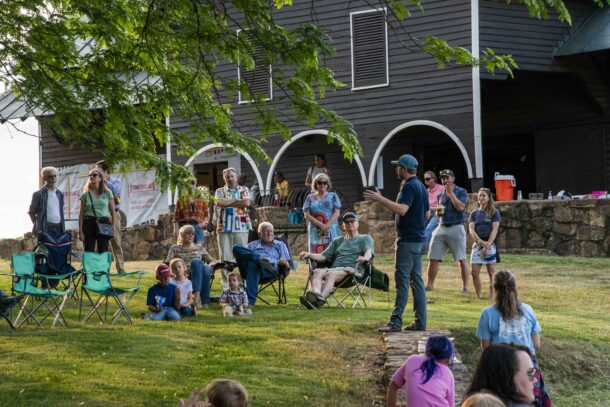The Friends of the Rappahannock (FOR) Education Department introduces our environmental STEM lessons to students via Design Briefs, which allow great flexibility in teaching concepts in environmental science and conservation to a wide variety of students.

FOR Educator Nancy Stalik helps middle school students test their design brief
Design briefs are scientific investigations On The Go. See an example of a “Build a Barge” design brief here. Unlike classroom teachers, we bring our brand of environmental science to students of all grades, all levels of previous knowledge, and all locations. We teach students from preschool to college with experience levels ranging from no previous background knowledge of our day’s subject to ones that have just finished a similar unit. We teach in different classrooms throughout the Rappahannock Watershed, and while our locations may differ, our subject, environmental science and conservation, remains the same. The vehicle we use for our Environmental STEM (E-STEM) activities is the Design Brief. Its versatility allows FOR educators to connect with students in all grades with all levels of previous subject knowledge.

Elementary students work with unlimited resources from the “materials” section
Design briefs contain four simple sections that allow students to identify with the given challenge and begin to formulate a solution. The “background” section reminds the students of a previously encountered concept, relates an essential kernel of knowledge, or sets the stage for a scenario. The “design challenge” section clearly states what they are to design and build. The “criteria” section informs students exactly what a successful prototype must do. Lastly, the “materials” section tells them the available resources they have to create their prototype. These are the bare bones for teaching with a design brief.

Students test their “Build a Barge” design brief with FOR educator Meredith Palumbo
Depending on the sophistication and previous learning of the students we add or subtract criteria to make the challenge harder or easier. For instance, a budget can be stipulated in the criteria with costs assigned to materials. Our design briefs always have materials that student groups can only have one set of. These are their limited resources. This includes time! We also offer a table of unlimited resources, which students can use thoughtfully. These represent their unlimited resources if they are not abused. (Yes, we always advance the idea of conservation in all our lessons!) Design briefs yield the flexibility to differentiate instruction across a wide spectrum of students.
After student groups design and create their challenge item, it is time to test. We test prototypes in front of the whole class for two reasons: if a group’s prototype does not perform well, everyone can learn from it, and if a group’s prototype does perform well, everyone can learn from it. Either way, everyone learns and has fun doing it!
Nancy Stalik
Environmental Educator

